Use [CONTR + F] to search this page and pull down this scroll bar to see everything. 
|
Use [CONTR + F] to search this page and pull down this scroll bar to see everything.
|
Survey of First Day Sheets |
|
Let's start with some explanatory notes about these first day sheets, eerstedagbladen in Dutch. Since 1981 stamp issues were accompanied by first day sheets from private entrepreneurs showing the emission with a first day cancellation. The back of the sheet provides extensive information about the emission in Dutch, information which can also be found in a proper catalogue. There are a few characteristics that tell us something about the makers. Here they are: Characteristics of the Importa series:   Characteristics of the Select series:   Characteristics of the The Hague Maxi series:   Characteristics of the fish series:    |
  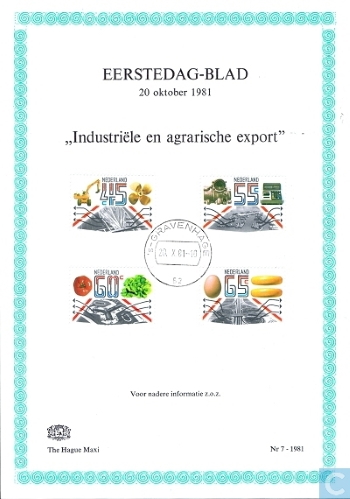  the back of above sheet:  |
20-10-1981: Two First Day Sheets number 5, one number 7 and one number 3/1981: with an emission of 4 stamps about export, one of which shows Kijfhoek shunting yard. There are no less than four different copies of this issue, which tells us something about the eagerness of some people to earn a lot from this. Kijfhoek is a marshalling yard between Barendrecht and Zwijndrecht. It is 50 hectares in size, has a two-track hill and has 14 arrival tracks, 43 distribution tracks, all with rail brakes, and 12 departure tracks. Kijfhoek has a capacity of 4000 freight wagons per day. The marshalling yard is located in the municipality of Zwijndrecht. Kijfhoek is an important link in the distribution of goods from the port of Rotterdam to the European hinterland. The trains are assembled at Kijfhoek in the so-called hill process. The Rotterdam port railway line connects the Maasvlakte to Kijfhoek and freight wagons from Kijfhoek can be reached further to Rotterdam or Dordrecht from where the whole of the Netherlands and Belgium can be reached. The Betuweroute offers a connection to the Central and Southern European hinterland. In 2004, approximately 200,000 wagons were handled at Kijfhoek, about a third of which contained hazardous substances. The marshalling yard replaced the older marshalling yards Feijenoord, IJsselmonde, Rotterdam-North Goods, but also took over tasks from Amsterdam-Rietlanden, Watergraafsmeer and the marshalling yards of Amersfoort, Onnen and Zwolle. The traffic control post of Prorail is located at Kijfhoek, from where the entire Betuweroute is controlled. [source: wikipedia] |
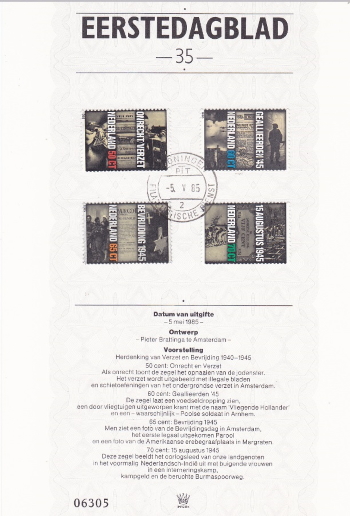  |
05-05-1985: Two First Day Sheets number 35: emission of 4, the last one shows building the Death Railway. The Burma-Siam Railway, also called Burma Railway. Death Railway, is the nickname given by World War II Allied prisoners of war to the railway they were forced to build between Nong Pladuk in Thailand and Thanbyuzayat in Myanmar (Burma). Work on the railway began on September 16, 1942 and was completed 16 months later, despite calculations by Japanese engineers that it would take at least 5 years to construct the 415-kilometer long and 1-meter-wide railway. The Japanese made extensive use of forced labor for this. During construction an average of 75 workers died each day; 15,000 prisoners of war died from exhaustion, disease and malnutrition. Among them were 7,000 British, 4,500 Australians, 131 Americans and nearly 3,000 Dutch. Among the Western prisoners of war were many KNIL soldiers and Dutch from the then Dutch East Indies. Also, about 100,000 Thai and Indonesian Romashas and Burmese and Malaysian forced laborers died in construction through the difficult area. After the completion of the railroad in December 1943, the work involved maintenance and repair of damage from Allied bombers. The labor camps were often next to vital points of the railway, so bombing also caused many casualties and injuries among the forced laborers. The dead, who were initially buried along the railway, were later (re)buried in three war cemeteries: Chungkai and Kanchanaburi in Thailand and Thanbyuzayat in Burma. These were built on the initiative of the Commonwealth War Graves Commission, the British sister organization of the Dutch War Graves Foundation. Many survivors later experienced mental problems. Their descendants have also had problems: the so-called second-generation syndrome. One of the best known residents of one of the camps of workers who had to work on the railway was the Dutch comedian Wim Kan. He was a helper from the camp doctor and therefore did not have to work on the railway. The first train to cross the railroad was a brothel train for Japanese officers. In the west, the railway is mainly known from the movie The Bridge on the River Kwai. The river was called Mae Klong at the time the bridge was built, but was renamed Khwae Yai in the 1960s when the bridge became internationally known through the film. Today the line is still in use up to Nam Tok in Kanchanaburi province. After the bridge near the city of Kanchanaburi, the railway largely follows the course of the river Khwae Noi (called Khwae until the 1960s). [source: wikipedia] |
  |
20-06-1989: Two First Day Sheets number 75: 150 Years of Dutch Railways. In 1989, the railways in the Netherlands existed for 150 years and at the height of the development at that time, reason was found to be big, under the title 'Trains through Time'. In 1989, the railways were not yet in their grasp of independence, division and market forces. The event started on September 6, 1988, when the newly refurbished locomotive 3737 made a special ride on a Pullman train from Amsterdam via the Oude Lijn to Rotterdam. On Sunday February 19, 1989, the electric locomotive number 1607 'Vlissingen' made a trip from Kijfhoek to Eindhoven with the longest train in the Netherlands. The length of this train, consisting of a locomotive and sixty Intercity coaches, was 1,607 meters. That was also the reason that the locomotive with the number 1607 was pulling power of the train. On the side walls of the locomotive was the text: "I pulled the longest passenger train in the world". The reason for this stunt was the commemoration of 150 years of trains in the Netherlands. With the ride, they wanted to check whether the braking system was still working satisfactorily on such a long train. The NS had planned to run much longer trains in the freight department, and the answer to this question was important for this. The test was successful and the train reached Eindhoven station without significant problems. The composition of the train was: 1607 + B + A + 4B + A + BKD + 2B + A + 3B + 13A + 29B + 4BKD. The ICR coaches indicated the tens in large numbers and also the text "The longest passenger train in the world". Incidentally, a longer train ran in Belgium two years later. Length of this train with seventy carriages was 1733 meters and weight 2786 tons. During the summer of 1989, even more trips with special equipment were driven through the country. Various steam and electric locomotives were available for this. Various locomotives came to Utrecht especially for this anniversary. In the Jaarbeurshallen a large exhibition was devoted to the railway anniversary under the title 'Trein & Co', as well as the 'Tweede Dimension'. Locomotive 'De Arend' was also present here. After a major repair, the locomotive was also ready to drive again for the first time in decades under its own power. Before this, a circular track was built in broad gauge, where the locomotive drove rounds with the three carriages for the public. A series of activities was organized on a number of disused freight tracks and at the former post platform at Utrecht Central Station on the Jaarbeurs side. The centerpiece was the material exhibition. A variety of trains was set up at the exhibition yard. From old to very new and from 'private' property to equipment of the NS itself. The Manifestation in Utrecht was opened on June 21 by Queen Beatrix, who comes to this end by Royal train from The Hague. On July 1, 1989, a more than five-hour marathon television broadcast was provided by the NOS from a train in which many aspects of the railway company were highlighted. To this end, the decorated NS 4083 front-end train set made a journey through the country. A TGV trainset also arrived in Utrecht for the first time. [source: wikipedia] |
 |
25-08-1992: First Day Sheet number 113: Westerbork concentration camp. Camp Westerbork (German: Judendurchgangslager Westerbork) was a transit camp near Hooghalen in the then municipality of Westerbork in Drenthe during the Second World War. The camp was a portal from which more than 102,000 Jews living in the Netherlands and 245 Roma were deported by train to concentration and extermination camps in Germany, Poland and the Czech Republic. The camp location was originally established by the Dutch government in the summer of 1939 to serve as a refugee camp for Germans and Austrians (German and Austrian Jews in particular), who had fled to the Netherlands to escape Nazi persecution. However, after the German invasion of the Netherlands in May 1940, that original purpose no longer existed. By 1942 Camp Westerbork was repurposed as a staging ground for the deportation of Jews. Transport trains arrived at Westerbork every Tuesday from July 1942 to September 1944, and deported an estimated 97,776 Jews during the period. Jewish inmates were deported in waves to Auschwitz concentration camp (65 train-loads totaling 60,330 people), Sobibor (19 train-loads; 34,313 people), Theresienstadt ghetto, and Bergen-Belsen concentration camp (9 train-loads; 4,894 people). Almost all of the 94,643 persons deported to Auschwitz and Sobibor in German-occupied Poland were murdered upon arrival. [source: wikipedia] |
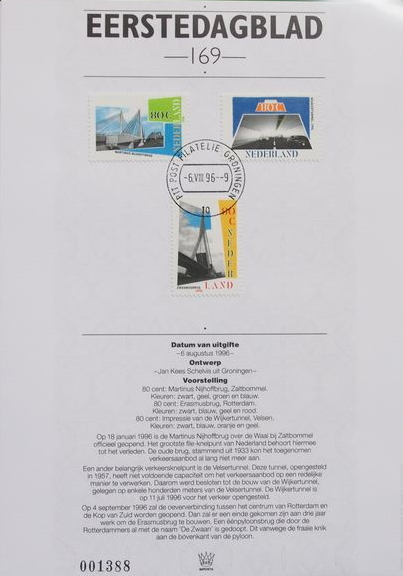 
|
06-07-1996: First Day Sheet numbers 169 and 174: Bridges. The third stamp in this series shows the Rotterdam Erasmus Bridge, a combined cable-stayed and bascule bridge. Construction began in 1986 and was completed in 1996. It crosses the Nieuwe Maas in the centre of Rotterdam, connecting the north and south parts of this city, second largest in the Netherlands. This bridge is also used by the tram in the city. The bridge was named in 1992 after Desiderius Erasmus, a prominent Christian Renaissance humanist, also known as Erasmus of Rotterdam. The Erasmus Bridge is Rotterdam's most important landmark and is even part of the city's official logo. [source: wikipedia] |
  |
07-09-1999: First Day Sheet numbers 223 and 231: Stork Machine Company. Stork B.V. is a Dutch manufacturing and service providing company with its headquarters in Naarden. Stork was founded in 1868 by Charles Theodorus Stork. In the 20th century the company merged with others. In 1954 with Werkspoor, founded in 1827. Werkspoor N.V. was the shortened, and later the official name of the Nederlandsche Fabriek van Werktuigen en Spoorwegmaterieel. It was a Dutch machine factory, known for rolling stock, (ship) steam engines, and diesel engines. It was a successor of the company Van Vlissingen en Dudok van Heel, later named Koninklijke Fabriek van Stoom- en andere Werktuigen. In 1996 Stork acquired the still healthy parts of Fokker, creating a new division. By 2007 four divisions were left of Stork. [source: wikipedia] |
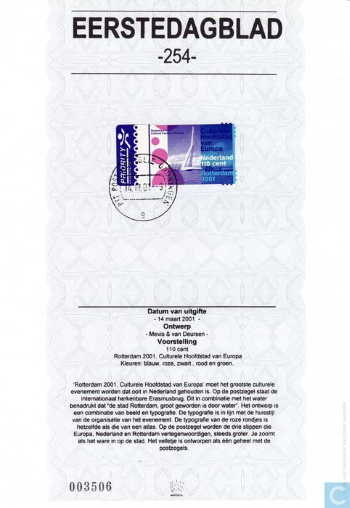  |
04-03-2001: First Day Sheet number 254: Rotterdam European cultural capital with Erasmus Bridge. The Erasmus Bridge is the second bridge over the Nieuwe Maas in the center of Rotterdam in the Port of Rotterdam next to the Willemsbrug and is named after the Dutch priest and humanist Erasmus. The bridge connects the Kop van Zuid district with the center on the north side of the river. The Erasmus Bridge was designed by Ben van Berkel (UNStudio) and delivered in 1996. The 284 meter long cable stayed bridge has a 139 meter high kinked asymmetrical steel pylon. This gives the bridge the nickname "De Zwaan". Between the Kop van Zuid and the pylon there is an 89-meter long bascule bridge for ships that cannot pass under the cable-stayed bridge. This bascule bridge is the largest and heaviest bascule bridge in Western Europe. The bridge is also used by the tram. [source: wikipedia] |
 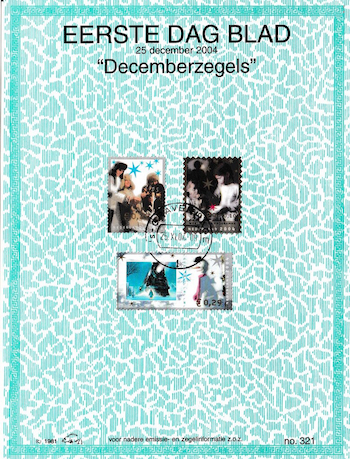
|
25-11-2004: First Day Sheet number 351: Polar Express with steam locomotive on tab. The Polar Express (2004) is an American animated film that uses 3D techniques. The movie was directed by Robert Zemeckis and is a production of Warner Bros. Entertainment. The main role is played by Tom Hanks, who has made several successful films with Robert Zemeckis. It premiered on December 8, 2004 and the movie has a running time of approximately 90 minutes. The film is based on the children's book by writer Chris Van Allsburg. Story: it is Christmas Eve. While a boy tries to fall asleep, he hears the sound of a train. When he steps outside he sees an immense train, which is called The Polar Express. A conductor with a mustache gets out of a car and asks if he wants to get on the train. The boy hesitates for a moment but still jumps on the train, so he and the other children experience an unforgettable adventure. [source: wikipedia] |
 
|
12-04-2005: First Day Sheet number 329 and First Day Sheet number 362: from Beautiful Netherlands (Mooi Nederland) sheets Rotterdam and Weesp: Rotterdam with Erasmus Bridge. See above for Erasmus Bridge. |
  |
14-10-2005: First Day Sheet numbers 372 and 338: Dutch trains. The four Dutch trains are the following (clockwise from upper left): 1] The "Blauwe Engel" (Blue Angel). Plan X, earlier: rolling stock DE1 and DE2, better known as Blauwe Engel, was a Dutch diesel-electric train. The name was taken from the bright blue color that these trainsets initially had. This equipment was built in 1953-1954 by the Rotterdam rolling stock manufacturer Allan (in full: Allan & Co's Koninklijke Nederlandsche Fabrieken van Meubelen en Spoorwegmaterieel NV) on behalf of the Dutch Railways. 30 motor vehicles DE1 (numbered 21-50) and 46 two-part trainsets DE2 (numbered 61-106) were built. A DE1 had only two compartments (smoking and no smoking). So there was no separate 1st class compartment, instead eight seats in the non-smoking compartment had a different seat cover and these were considered 1st class. The entire series was built under the name Plan X, but this name was really used for the couples that were modernized and painted yellow in 1975. They also got new numbers: 161 to 186. The Blue Angels are no longer in service, but several copies have been preserved. 2] Steam locomotive 3737. The NS 3700 series was a series of express train steam locomotives with the 2'C axle layout of the Dutch Railways (NS) and its predecessor Company for the Operation of State Railways (SS). The first 109 locomotives from this series were delivered to the SS in the years 1910 to 1920 and numbered 685 - 778 and 785 - 799. The manufacturers were Beyer, Peacock and Company (36 pieces), Werkspoor (48 pieces), Hanomag (10 pieces) and Henschel & Sohn (15 pieces). After the merger of the equipment fleet of the SS and HSM in 1921, 6 machines were supplied by Werkspoor in the same year. The series then received the NS numbers 3701-3815. In 1928 an additional order of 5 slightly different locomotives from Schwarzkopff was added. The entire number series then became 3701-3820. Locomotive 3737, the original SS 731, built in 1911 by Werkspoor, made its first test run between Amsterdam and Utrecht on August 28, 1911. She was officially placed in service on September 11, 1911. Locomotive 3737 (from the Roosendaal depot) ran the last official NS steam train from Geldermalsen to the Utrecht Maliebaan station on 7 January 1958, where the Dutch Railway Museum was already located at that time. The 3737 locomotive was then added to the museum's collection. 3] The Intercity-Express, abbreviated as ICE, is the fastest train of the DB Fernverkehr railway company, part of Deutsche Bahn AG. It is also the highest train category. The high-speed trains are built by Siemens. ICE International is the name of the international high-speed network and partnership of German railways (DB Fernverkehr) and Dutch Railways (NS International). ICE International is offered between the Netherlands and Germany and between Belgium and Germany. ICE International operates two main lines: Amsterdam Centraal - Frankfurt (Main) Hbf and Amsterdam Central - Basel SBB v.v. are offered from the Netherlands. 4] Intercity rolling stock (ICM for short) is a train set of NS Passengers that is mainly used in intercity train services. The material name is Plan Z. The train, designed by the design agency of designer Raymond Loewy, was nicknamed Koploper (Frontrunner), because of the so-called walk-through head. This walk-through head was removed after the modernization of the trainsets. The overhauled trains are also called Intercity equipment modern (ICMm for short). The first trainsets entered service in 1977. The trains built between 1983 and 1994 still run daily on the Dutch rail network and, together with the VIRM, form the most important equipment on the connections from the Randstad to the rest of the country. [source: wikipedia] |
 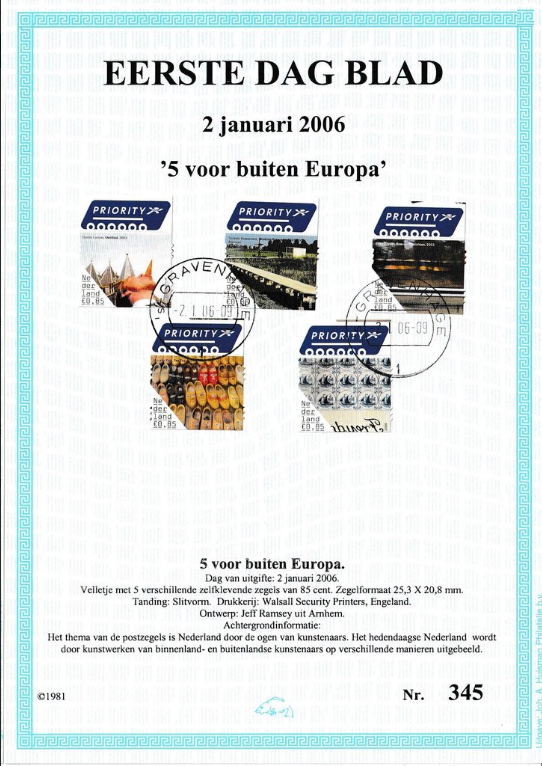 |
02-01-2006: First Day Sheet number 379: Dutch train rushing past in: 5 outside Europe. |
 
|
02-01-2006: First Day Sheet numbers 344 and 378: with art work Lost Luggage Depot in Rotterdam. Lost luggage depot is a cast iron work of art that has been standing on the Koninginnehoofd, the western tip of the Wilhelminapier in Rotterdam, since 2001. The artwork was created by Canadian historian and visual artist Jeff Wall as a symbol of the farewell emigrants took here from their "past lives". The statue consists of an octagonal pavilion with three floors and a diameter of ten meters. Found objects such as bags, shoes and suitcases are located on all floors. Everything is made of cast iron, the total weighs about 65,000 kg. The client was the city of Rotterdam. In 1990 he had received a national gift of 1,000,000 guilders in the context of 50 years of reconstruction and 650 years of city rights. The assignment was carried out by the Zeeuws-Vlaamse Gieterij from Sas van Gent, who was also charged with the placement of the statue. On November 3, 2001, the statue was opened by Prime Minister Wim Kok. [source: wikipedia] |

|
11-12-2006: First Day Sheet number 401: with railway bridge "De Hef". De Hef is the popular name for the Koningshaven Bridge, a railway lift bridge over Rotterdam's Koningshaven that has been taken out of use for rail traffic since 24 September 1993. The bridge was part of the railway line Breda - Rotterdam. The Koningshaven separates the North Island from the Feijenoord district. The bridge sections of the Koningshaven Bridge on the mutual banks date from 1878. The middle section was originally a swing bridge. However, this was a major hurdle for shipping. Several ships moored in the narrow passage, in 1918 the German ship Kandelfels sailed against the pier. The latter accident was decisive for the construction of a lift bridge to replace the swing bridge. The bridge was designed by engineer Pieter Joosting and opened on October 31, 1927. This bridge was the first of its kind in Western Europe. Joris Ivens made an avant-garde film about De Hef in 1928 entitled De Brug. Partly because of this film, Ivens became internationally known. After the commissioning on 24 September 1993 of the Willemsspoortunnel for train traffic between Central Station and South Station, it was possible to focus on the demolition of the redundant route. This consisted of the two Maasbruggen De Hef and the Willemsspoorbrug (the other Maasbrug in line with De Hef) and the Luchtspoor. After wide protests from Rotterdammers, the demolition of De Hef was abandoned. This bridge is now a National Monument, a monument in memory of the place where trains once left the center of Rotterdam. The rest of the track was demolished. [source: wikipedia] |
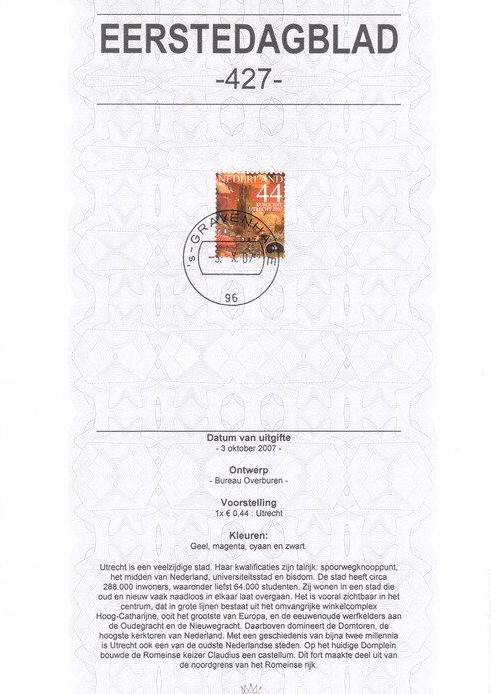  |
03-10-2007: Two First Day Sheets number 427 and 394: stamp from Beautiful Netherlands (Mooi Nederland) sheet: Utrecht, showing the administrative building III of the Dutch Railways (NS), called The Inkwell (Dutch: inktpot). The Inkwell is the largest brick building in the Netherlands, designed by George van Heukelom on behalf of the interest group Nederlandsche Spoorwegen (NS). The national monument is located at the Moreelsepark in Utrecht near Utrecht Central Station and it is currently used as ProRail's head office. The Inkwell was built with 22 million brick stones. Due to the scarcity after the First World War, construction was taken into the hands of the NS. Two brickworks, a wood company and three ships were purchased. Since 4000 cubic metres of oak wood was required, a Limburg forest was also purchased. Due to the scarcity of building materials, 21 kilometres of old rails were used for the foundation of the building. Also located in "De Inktpot" is a water tower installed in 1921 with a reservoir of 27 cubic meters, which was also designed by Van Heukelom. The park in front of the building, including sintered stone walls, is also his design; his furniture designed for the building has been adapted over the years. Jan Schouten provided the stained glass for the building. In the Second World War, NS remained an independent company, but came under German supervision. The building was then partly occupied by the Bahnbevollmächtigter bei den Niederländischen Eisenbahnen. It is a common misunderstanding that the German SS would have used "De Inktpot" as its headquarters. The building was renovated between 2000 and 2002 on behalf of the then owner, NS Vastgoed. In 2016, ProRail purchased the building, together with Hoofdgebouw II (De Tulpenburgh). [source: wikipedia] |

|
28-04-2009 : First Day Sheet number 462: Beautiful Netherlands (Mooi Nederland): Roosendaal. Due to its location on the railway (Amsterdam -) Rotterdam - Antwerp (- Brussels - Paris) Roosendaal fulfilled an important international logistics function. Roosendaal is the last station on Dutch territory before the border with Belgium. The Amsterdam - Brussels intercity stopped here. Since the beginning of April 2018, this train has been crossing HSL South, via Breda, which already fulfills an important border function for car traffic (A16 / E19). In 1854, a Belgian company constructed a railway from Antwerp over Roosendaal to Moerdijk, including a side branch from Roosendaal to Moerdijk. This provided an impulse for the development of the village of Roosendaal. Connections with Rotterdam (1877) and Vlissingen (1872) made Roosendaal station a real railway junction. Expedition companies soon established themselves near the border station. To accommodate the growth of international passenger and freight transport, a new and much larger station complex was opened in 1907. [source: wikipedia] |
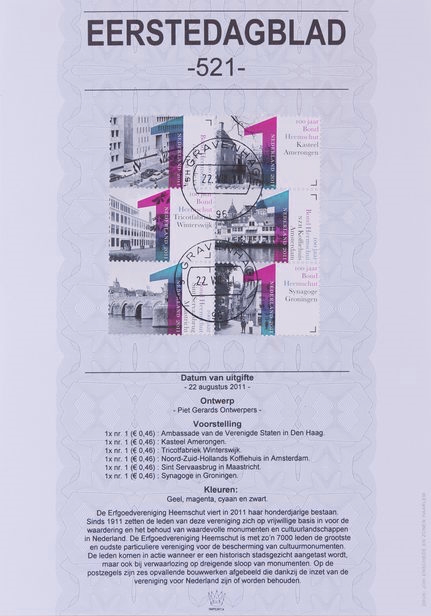
|
22-08-2011: First Day Sheet number 521: One hundred years "Heemschut". Heemschut is a sort of National Trust that protects our cultural heritage. It is a private association though. One of the buildings that was protected from demolition in 1972 is the Amsterdam "Noord-Zuid-Hollands koffiehuis", a café in Station Square by architect J.H.W. Leliman, one of the founders of "Heemschut". It was rebuilt in 1980 in front of Amsterdam Central Station, which is in the background. The café is in the middle on the right. Furthermore there is the St.-Servaas bridge in Maastricht in the fifth stamp. This bridge carried a streetcar until 1914. |

|
01-09-2011: First Day Sheet number 522: "Green mail". These stamps originate from a sheet of 10 stamps for national use. All ten stamps have an environmental subject, two of which are related with the train. The stamp on top shows a suitcase with the text: "travel consciously, let the environment relax" (in Dutch: Bewust reizen. Laat het milieu ontspannen). And of course we all know that taking the train is a very environment-friendly way of travelling. The other stamp shows a bus, but the text also applies to rail travel: "Go forward fast with electric transport" (in Dutch: Snel vooruit met elektrisch vervoer). Most railway lines in The Netherlands are electrified, so this text is also appropriate for the railways. |
 
|
18-06-2012: First Day Sheet numbers 546 and 547: The Netherlands in the Bos Atlas. The Bosatlas is a Dutch atlas which is used in most schools. It still is the best selling atlas in the Netherlands. The atlas was started by Pieter Roelf Bos, a Groningen teacher. The first atlas was published in 1877 with the name "Bos' Schoolatlas der geheele aarde" (Bos's School Atlas of the Whole Earth). Later editions were named Bosatlas. The reason for first publication was the introduction of geography in Dutch high schools. The maps were originally drawn by hand. The publisher was Jan Berend Wolters of Groningen, whose firm continues to publish the atlas as Wolters-Noordhoff. Bos continued to look after the production of the atlas until his death in 1902: his final production was the 15th edition. The last of his successors to take individual responsibility for the Atlas was F.J.Ormeling (1976–1981). Since 1981 responsibility for the atlas has been collectively attributed and it is the publisher's name that has been highlighted in the atlas and associated marketing material. Several stamps show the railway lines in the maps. [source: wikipedia] |
 
|
28-01-2013: First Day Sheets numbers 564 and 565: 125th anniversary of ARCADIS (and KNHM). Arcadis designed the ecoduct (ecological viaduct) at Zanderij Crailoo near Hilversum. The ecoduct measures 800 metres and is one of the longest in its kind. It spans four obstacles, among which a very busy provincial throughroad and a railway line. This bridge connects two natural areas and it restored the ecological connection between them. The stamp showing a train which passes under the ecoduct can be found in the upper right hand corner of sheet 564. Another highlight of Arcadis' achievements is Amsterdam Bijlmer ArenA railway station. 60,000 passengers get in and out at this station daily. They enjoy the abundant daylight in the open spaces between the four viaducts. The 29 metres high glass roof seems to float on steel columns. The woodclad roof parts provide this Arcadis designed "Bijlmer cathedral" with a warm atmosphere. The stamp showing the station can be found in the lower left hand corner of sheet 565. |

|
09-09-2013: First Day Sheet number 586: The Peace Palace in The Hague is 100 years old. The Peace Palace (Dutch: Vredespaleis) in The Hague is the seat of international law because it houses the International Court of Justice. The Palace officially opened on August 28, 1913, and was built for the Permanent Court of Arbitration, created to end war as stated in a treaty at the 1899 Hague Peace Conference. Andrew Dickson White, whose efforts were instrumental in creating this court wrote to his friend Andrew Carnegie, who eventually provided 1.5 million dollars to build the Peace Palace. In the Great Hall there are several stained glass windows, one of which is called Industria. This window contains the image of a steam locomotive. The window was designed by Herman Rosse (1887 – 1965) and manufactured by J.W. Gips. It is to be seen in the stamp in the lower right hand corner. |
|
I don´t know if it exists. I have never seen one. |
08-09-2014: First Day Sheet number ---: 175 years of Dutch Railways. |
|
I don´t know if it exists. I have never seen one. |
30-03-2015: First Day Sheet number ---: Dutch bridges. |
|
I don´t know if it exists. I have never seen one. |
02-11-2015: First Day Sheet number ---: Children's stamps. |
|
I don´t know if it exists. I have never seen one. |
19-08-2019: First Day Sheet number ---: Public Transport. |
|
I don´t know if they exist. I have never seen them. |
They will follow as soon as I have found them. 
|